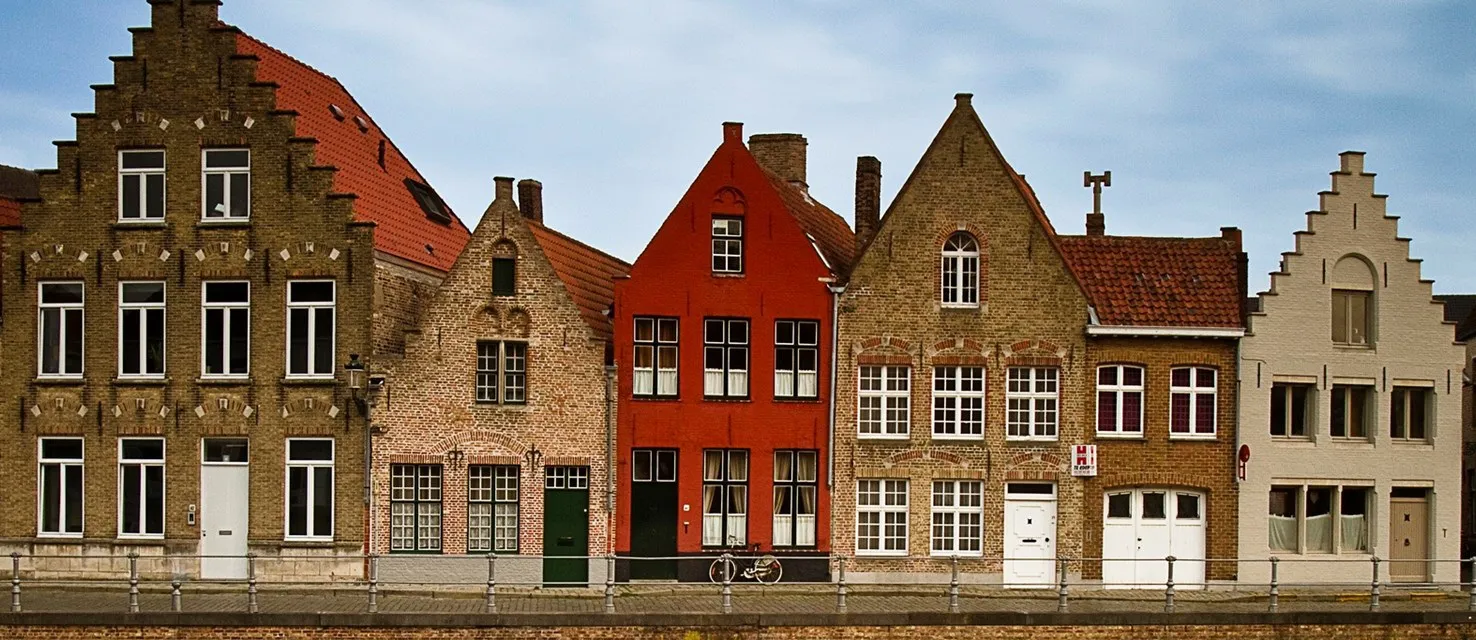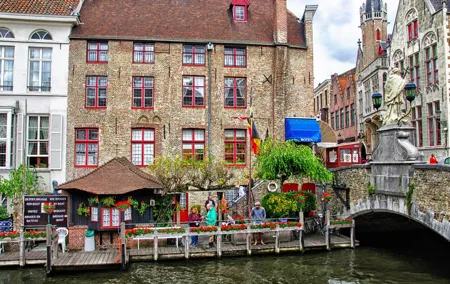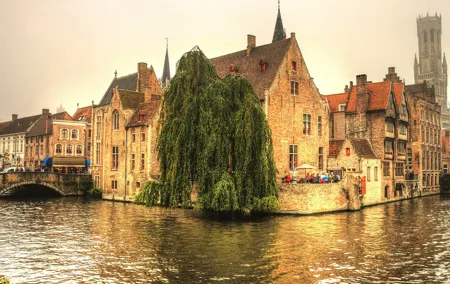Belgian city of Bruges
Bruges is a charming Belgian city that captivates from the first moments of being there. Here, if you put aside modern gadgets and ignore the cars, you can seriously think that you've traveled back in time to medieval Europe.
Bruges is a city of swans, canals, ancient cathedrals, traditional Christmas markets, and leisurely walks. In Bruges, every inch of cobblestone and every brick of the buildings breathes history, not a showy one, but real, with moss-covered, damp walls of houses, time-darkened facades, and quiet parks.
Getting to know this magical city is best started with a stroll around the main square, Grote Markt. A standard tour of Bruges would not be complete without visiting the Belfort bell tower (a UNESCO World Heritage Site), the nunnery of single widows, and the fine arts museum. Bruges also boasts interesting thematic museums: the Friet Museum, the Beer Museum, the Lace Museum, and the Chocolate Museum.
When to go?
Traditionally, tourists visit Bruges during Christmas to attend the local market and experience the festive atmosphere. However, it should be noted that the winter weather in Bruges is not the most favorable for walks. Winters in the city are damp, and the temperature rarely drops below zero degrees Celsius, making it quite chilly at this time. The best weather conditions for strolling through the ancient streets are observed in the summer season. If you want to explore the town without the crowds of tourists, opt for visiting in the mid-spring or early autumn.
What to buy?
Shopping in Bruges is quite captivating, as tourists usually bring back not clothes or shoes, but exclusive and atmospheric items that will remind them of a pleasant trip to the medieval city for a long time. Antique shops and flea markets, where you can find souvenirs and interior items from different epochs, are very popular in Bruges.
Belgian chocolate makes for an excellent gift for friends and relatives. In Bruges, you will find not just ordinary chocolate bars. Local chocolate boutiques sell works of confectionery art, and each candy is a creation of professional chocolatiers. Another souvenir that your friends will appreciate is Belgian beer.
Belgian lace is also a symbol of Bruges. Handmade lace items are distinguished by their extraordinary delicacy of workmanship and elegance of patterns. The variety of items is no less astonishing: nightgowns, aprons, curtains, tablecloths, napkins.
What to try?
It's hard to stay hungry in Bruges. Local dining places and street stalls offer a variety of delicacies. Of course, no menu, whether from a budget café or a fancy restaurant, would be complete without the Belgians' main culinary invention – French fries, which are consumed here both as a standalone dish and as a side, for example, with mussels in sauce.
Flemish cuisine is widespread in Bruges. Worth mentioning is the chicken soup "waterzooi", Belgian cheese, stewed rabbit, and fish soup. The most popular snack in the city is called "frikandel". This dish consists of fried potatoes, which can be accompanied by sauces, sandwiches, vegetables, and other toppings at will. Another favorite dish among locals is mussels, traditionally served in their shells with various sauces (wine, cream, garlic).
Where to stay?
Bruges is a tourist city, so finding accommodation shouldn't be a problem. However, it's worth noting right away that the cost of hotels here is slightly higher than in similar European cities. The historic part of Bruges is home to fashionable boutique hotels, where the rooms may even feature authentic antique furniture and vintage decor.
For budget travelers, there are several hostels available. In the modern districts of Bruges, there are quality chain hotels and mid-priced guest houses. Literally within five to ten minutes, you can find and book a hotel that meets your requirements perfectly.
Burg, 9
- Closed now
- $$$$
- Restaurants
- Pizzerias
Discover Amunì, a cozy dining spot in Bruges offering an authentic Italian experience. With mod...
Katelijnestraat, 1
- Closed now
- $$$$
- Restaurants
Otto Waffle Atelier is a family-owned waffle shop located in the heart of Bruges, known for its...
Simon Stevinplein, 15
- Open now
- $$$$
- Restaurants
- Cafes
- Coffee houses
- Bakeries
Le Pain Quotidien in Bruges is a charming spot offering a moderate price range of 9 to 23 EUR p...
Vlamingstraat, 14
- Closed now
- $$$$
- Restaurants
Nestled just beyond the bustling tourist area of central Bruges, Vlaminck '14 stands out as a h...
Wollestraat, 31
- Closed now
- $$$$
- Restaurants
House of Waffles in Bruges is the perfect spot to indulge in high-quality, freshly made Belgian...
Dweersstraat, 4
- Open now
- $$$$
- Restaurants
- Cafes
In the heart of Bruges lies "That's Toast," a delightful spot where the charm of European and i...
Katelijnestraat, 3
- Closed now
- $$$$
- Bars
- Restaurants
- Fast foods
FritBar, nestled in the heart of Bruges, is the go-to spot for anyone craving a blend of Americ...
Wollestraat, 12
- Closed today
- $$$$
- Restaurants
- Fast foods
The Olive Street Food in Bruges offers an authentic Greek culinary experience with a variety of...
Eekhoutstraat, 3
- Closed today
- $$$$
- Restaurants
- Bakeries
Nestled in the charming city of Bruges, 't Eekhoetje is a delightful spot for a leisurely meal....
Predikherenstraat, 11
- Open now
- $$$$
- Restaurants
- Cafes
- Coffee houses
- Bakeries
Sanseveria Bagelsalon in Bruges offers a delightful experience for breakfast, brunch, or lunch ...
Wijnzakstraat, 2
- Closed now
- Museums
Everyone has heard about Belgian chocolate at least once in their life, considered not just a r...
Wollestraat, 29
- Closed now
- Museums
The Oude Steen Torture Museum, true to its genuinely eerie essence, is located in the building ...
Vlamingstraat, 33
- Closed now
- Museums
The unique French Fry Museum occupies two floors of the medieval, yet well-preserved Saaihalle ...
Markt, 7
- Closed now
- Historical Buildings
For a whole 200 years, stone by stone, the tiers of the Gothic Belfry of Bruges rose upwards. T...
Markt
- Open now
- Historical Buildings
If you conquer all 366 steps leading to the viewing platform of the Belfort tower, the histor...
Burg, 13
- Closed now
- Churches, Cathedrals
The Basilica of the Holy Blood of Christ is the oldest and most significant building in all of ...
Steenstraat
- Closed now
- Churches, Cathedrals
Time has no power over the Saint Saviour's Cathedral, whose stone walls have survived fire, col...
Mariastraat
- Closed now
- Churches, Cathedrals
In the very heart of Bruges, near the Cathedral , lies the Church of Our Lady, whose age reach...
Breidelstraat, 3
- Closed now
- Museums
Belgian beer, much like its chocolate, is known worldwide. The most varied types, flavors, and ...
Hoogstraat, 10
- Closed now
- Attractions
The Waffles 'n Beer Workshop in Bruges is a must-visit attraction with a perfect 5-star rating ...
Hallestraat, 4
- Closed today
- $$$$
- Bars
- Pubs
@ The Pub in Bruges is the perfect spot for a night out. Nestled in a great location, this plac...
Wijngaardstraat, 13
- Closed now
- $$$$
- Bars
- Restaurants
Bieratelier Brugge in the heart of Bruges offers a cozy, vibrant atmosphere perfect for a relax...
De Garre, 1
- Closed now
- $$$$
- Bars
- Cafes
A quiet alley in the center of Bruges hides within one of its grey brick buildings the two-stor...
Langestraat, 135
- Closed now
- $$$$
- Bars
- Sports Bars
Bauhaus Bar in Bruges is a vibrant nightlife hotspot known for its wallet-friendly prices, with...
Kartuizerinnenstraat, 6
- Closed now
- Breweries
You can talk about beer as much as you want, but never actually try the real drink that is only...
Vlamingstraat, 37
- Closed now
- $$$$
- Bars
- Sports Bars
Nestled just a few streets away from the center of Bruges, The Monk is a vibrant spot whether y...
Steenstraat, 96
- Closed today
- $$$$
- Bars
- Restaurants
ODA Rooftop Bar in Bruges is your go-to spot for nightlife, dining, and unforgettable views. Ra...
Philipstockstraat, 19
- Closed now
- $$$$
- Bars
- Breweries
- Restaurants
The Cambrinus Brewery can rightfully claim the title of the most famous landmark in all of Brug...
Langestraat, 69
- Closed now
- $$$$
- Bars
De Kelk in Bruges offers a gezellig atmosphere that ensures a memorable nightlife experience. W...
Walplein, 26
- Closed now
- Breweries
De Halve Maan Brewery is the only place in Belgium where the hop beverage is still brewed accor...
Minnewater, 1
- Open now
- Parks
Minnewater Park is especially popular among locals who seek respite from the endless hustle and...
Doornstraat, 110
- Closed now
- Playgrounds
- Fitness Clubs, Gyms
The "S&R Olympia" pool represents an entire complex of "tools" for effective water procedures, ...
Blankenbergse Steenweg, 420
- Closed now
- Fitness Clubs, Gyms
Nestled in the charming city of Bruges, Jumpsquare Brugge stands as an exhilarating destination...
Alfons de Baeckestraat, 12
- Closed now
- Parks
- Playgrounds
- Zoos
- Fitness Clubs, Gyms
- Theme Parks
Boudewijn Seapark is the true fountain of children's laughter, smiles, and good cheer in Brugge...
Koning Leopold III-laan, 50
- Arenas, Stadiums
- Fitness Clubs, Gyms
Jan Breydelstadion, opened in 1975, is nestled in the charming city of Bruges. Known for its ve...
Koning Albert I-laan, 200
- Cinemas
Kinepolis in Bruges is an entertainment hotspot perfect for movie enthusiasts. With 8 halls, it...
Park
- Open now
- Parks
Both in rainy and sunny weather, Koningin Astridpark is full of people scattered across its are...
't Zand, 34
- Entertainment
The concert hall in Bruges is a symbol not only of modern architecture but also of the city's a...
Bargeweg
- Open now
- Parks
Bargeplein in Bruges is a top-rated destination with a 4.5-star rating on Google. Built in 1970...
Sint-Jakobsstraat, 36
- Closed now
- Cinemas
Cinema Lumière Brugge is a charming cinema nestled in the heart of Bruges. Known for its consis...
Wollestraat, 53
- Closed now
- Shopping
It's hard to find a place like the 2be Beer Wall shop-bar, where visitors are offered a whoppin...
Mariastraat, 1c
- Closed now
- Shopping
The shop "The Old Chocolate House" is considered the most family-friendly establishment in Brug...
Simon Stevinplein, 19
- Closed now
- Shopping
The "Chocolate Line" shop is the most popular chocolatier in Belgium, where the world-famous tr...
Blankenbergse Steenweg, 420
- Open now
- Malls
B-Park winkelcentrum in Bruges, which opened its doors on October 22, 2008, offers an exception...
Zilverpand
- Open now
- Malls
Zilverpand Brugge offers an inviting shopping experience in the heart of Bruges. Located in the...
Eiermarkt, 6
- Closed now
- Shopping
The Dumon chocolate shop has become popular thanks to its handmade candies, which never have a ...
Wollestraat, 13
- Closed now
- Food Stores
"The Bottle Shop" boasts a distinctive feature that sets it apart from the rest of the "competi...
Vismarkt
- Markets
Fresh fish and seafood in Bruges are always guaranteed thanks to the Vismarkt market. From earl...
Sint-Pieterszuidstraat, 47
- Closed now
- Markets
Nestled in the charming city of Bruges, Amina Halal Supermarket offers a delightful shopping ex...
Walplein, 12
- Closed now
- Shopping
Near the main square in Bruges, directly across from the post office, sits the Käthe Wohlfahrt ...


































